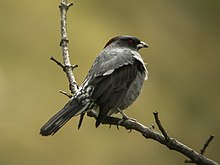Red-crested cotinga
| Red-crested cotinga | |
|---|---|

| |
| Scientific classification | |
| Domain: | Eukaryota |
| Kingdom: | Animalia |
| Phylum: | Chordata |
| Class: | Aves |
| Order: | Passeriformes |
| Family: | Cotingidae |
| Genus: | Ampelion |
| Species: | A. rubrocristatus
|
| Binomial name | |
| Ampelion rubrocristatus (d'Orbigny & Lafresnaye, 1837)
| |

| |
The red-crested cotinga (Ampelion rubrocristatus) is a species of bird in the family Cotingidae that can be found in Columbia, Sierra de Perija, and Andes from Venezuela, and Colombia to Bolivia. An adult red-crested cotinga is gray with a white tail a white bill base and a tuft of red feathers. The red-crested Cotinga can be found in a cloud forest on a treeline and pairs in small groups. The main diet consists of fruits and sometimes insects. The species is not threatened globally and is fairly common in its native regions. [2]
Description
[edit]A male red-crested cotinga averages around the size 21-21.5 cm; males 51-80g and females vary around 47-67g. A Plain cotinga with long crests usually lay flat along a nape; they can be conspicuously displayed raised and spread transversely. The red-crested cotinga plumage is gray, darker on the head, wings, and tail, nuchal crest chestnut-maroon, white streaking in tail-coverts above and below extending degrees across the rump. Red-crested cotinga has extensive pale feather fringes and a brownish-red coloration on the head and neck. Immature red-crested cotinga with lighter coloring than an adult, pale feather fringes, scattered red color primarily on head and neck, and undergoes a series of successions before acquiring adult plumage. [2]
Subspecies and Distribution
[edit]The red-crested cotinga belongs to the subspecies monotypic, a genre that only includes one species. They are natives of N Columbia, Sierra de Perija, Andes from W Venezuela, and Columbia S to Bolivia. The red-crested cotinga is a non-migratory species. [2]
Habitat
[edit]The red-crested cotinga is found on the wedges of cloud forest, inhabits patches of trees and bushes, and is locally found in hedgerows with trees bordering agricultural land. The habitat type of the red-crested cotinga is forest, artificial, and a terrestrial system.[3]
Movement
[edit]The red-crested cotinga is known for its distinctive movement patterns, characterized by quick, direct flights through the canopy of montane forests. These birds are often seen in small groups, moving agilely between branches in search of fruits, insects, and other small prey, showcasing their aerial dexterity. [2]
Diet and Sound
[edit]The red-crested cotinga’s diet consists of fruits and occasionally insects. They catch their food from a perched position and then fly out to catch the insects either individually or in small groups of up to 6. The sound of red-crested cotinga is a guttural frog-like noise (rrrr) or a series of soft nasal (eh- eh- eh). [2]
Breeding
[edit]There is no clearly defined breeding season. The Red-crested Cotinga will rise and spread crest lifts, tails, and bows during courtship. Their nest is made up of large cups of mosses, lichens, and twigs. [2]
Conservation Status
[edit]The Red-crested Cotinga is not threatened globally and it’s fairly common. Their tolerance range is very wide and they have a variety of disturbed habitats to ensure that they survive. Their protected areas range from Sierra Nevada National Park (Venezuela), Munchique National Park(Colombia), to Podocarpus National Park (Ecuador). [2]
References
[edit]- ^ BirdLife International (2016). "Ampelion rubrocristatus". IUCN Red List of Threatened Species. 2016: e.T22700753A93794819. doi:10.2305/IUCN.UK.2016-3.RLTS.T22700753A93794819.en. Retrieved 12 November 2021.
- ^ a b c d e f g Snow, David (2020). "Red-crested Cotinga (Ampelion rubrocristatus), version 1.0". Birds of the World. doi:10.2173/bow.reccot1.01. ISSN 2771-3105.
- ^ "Red-crested Cotinga Ampelion rubrocristatus".

